#i love their non-biblical symbolism
Photo


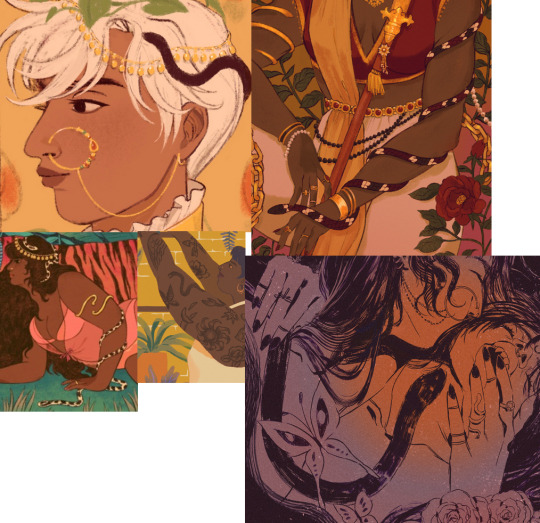
Artist Confession: I draw alot of snakes and love them aesthetically but I am scare of them irl.
#its comical#i respect them as creatures and hope no harm befalls them ofc!#i love their non-biblical symbolism#south asian art#snake
101 notes
·
View notes
Note
Hey Petty! I love reading your colour-analysis posts a lotttt and recently came across your posts about DFF. Started watching it because of you and it's soo good! So, I noticed you're starting to suspect White. But come on, isn't he literally named "White"?! I really don't see him being mixed up in all the drama like the others. My bet's on him being the last girl standing (like many others ig). What's your take on it??
I love color symbolism, but maybe it’s because I played Clue too much as a child, I actually don’t trust anyone in this show. White has proven several times to be as pure and innocent as his name, but . . . is he too good to be true?

The biggest reason I want White to not be so innocent in all of this is because this is traumatizing. If White truly had no idea what he was in for, this boy will need a good therapist and to stay hydrated the rest of his life. So by me thinking something is up with him, it helps me cope with the idea that maybe he isn’t being traumatized, but actually in on the traumatizing.
And then, there are the other reasons:
The Tumblr detectives have stated that White is rich. Possibly richer than Por. He went to a private school, not the ones the boys went to.
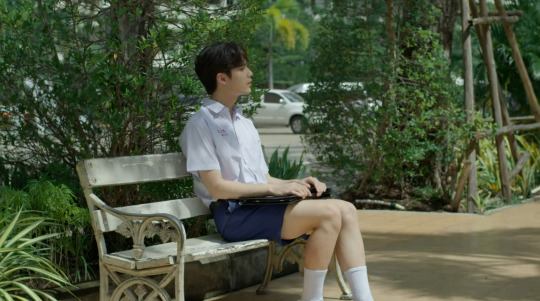
Yet Tee tells him that he will treat them to the US to see Jin when he has enough money.

I’m not one to question power dynamics in a relationship, but it’s odd because the OST makes it seem like White approached Tee first, as if Rich Boy White initiated this relationship with older Tee . . . without knowing anything about him.
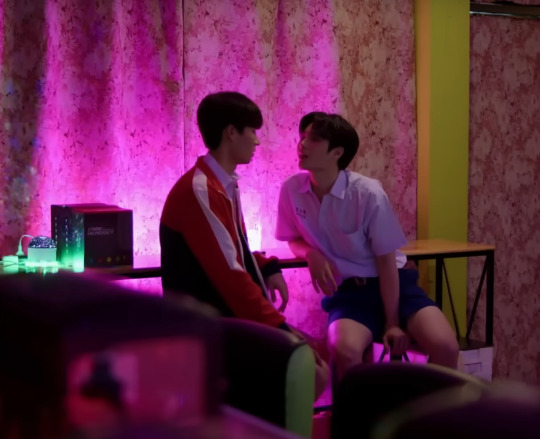
We still have yet to get backstory on White. He is dating Tee. That’s it! The music video showed us more scenes from them, so how did they end up falling in love in an arcade?

He is resourceful. He plugged in the walkie-talkies. He found the video and a gun. He cries when screamed at. But is he using those tears as another resource? If white women weaponize their tears, why can’t White?
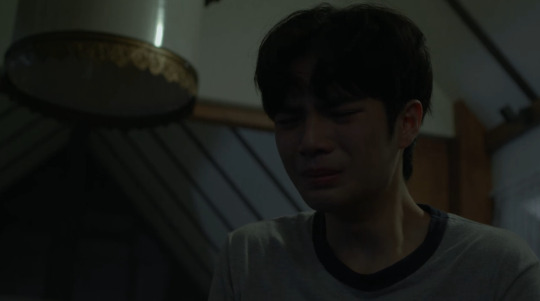
And who does he turn those tears against the most? Tee!

I believed White wasn’t New because I could not imagine Non’s brother actively dating (and fucking) his brother’s bully, but why is White dating Tee? Tee had some people convinced he was a good guy in the first episode, but NOT ME! Once he said that White was being disobedient, I was ready to push him off that terrace, but The Hand got to him first.
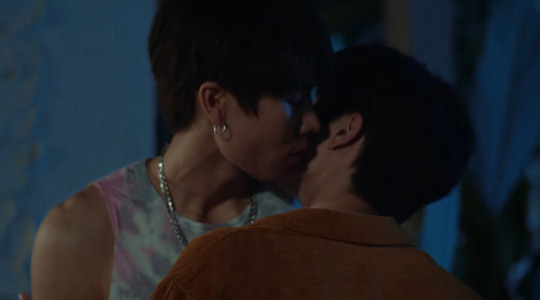
As Fluke pointed out, it’s strange White didn’t know about Uncle Joe. It kind of makes sense to not know about family members since even Tee’s friends didn’t really know about the uncle, but this rich boy doesn’t know his boyfriend of over two years had an uncle (regardless of the money laundering) ESPECIALLY because Tee’s ass was always at that gambling hall. Tee openly showed he is not the type to just let his boyfriend be alone, so how did Tee explain not being near White every second of every day?

White wasn’t supposed to be on this trip, but he begged Tee to let him come. Tee apologized for this, but White put on a smile and said all was well. White wants to be with Tee, and he seems to want Tee to be with him, right in the middle of the action.

So either White is a metaphorical angel sent from heaven who can endure even the worst tragedies or he is a biblical angel sent to punish these boys, specifically Tee, for their crimes.

Either way, he is an angel
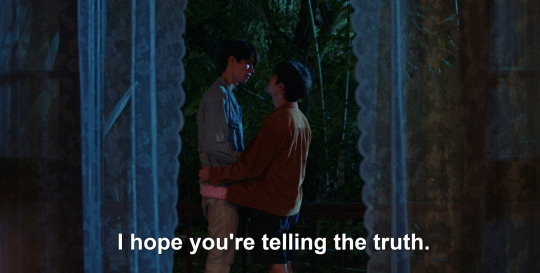
who will survive!

#dead friend forever#all these boys are sus#white may be perfect#but he could also be the perfect suspect#I need to know why he is dating Tee!#I need to know that backstory right now!#White will be the final gay#but is going to be traumatized?#or is he doing the traumatizing?
49 notes
·
View notes
Note
re: Mordor's location
I'm confused! I can understand being annoyed that Mordor is in the east (for me, it's because any new birth/new beginnings symbolism fails. BUT on the other hand, it works great with tolkien's biblical stuff - from study.com, "'East of Eden' is an allusion to the Biblical Book of Genesis. After Cain murders his brother Abel, he is exiled to the land of Nod, 'east of Eden' (Genesis 4:16)". I LOVE Tolkien's biblical symbolism, and smeagol murdering his brother is a direct cain/abel reference, so having the evil be to the east really works for me.
So I guess I'm just wondering if a) the symbolism thing is what irritates you about Mordor's location (or if there's something else I'm missing), and b) how does the evil being in the north resolve this?
Hey cool question!
Caveat that I’m literally just liveblogging my first ever read of LOTR, so while I read Hobbit as a kid and I know the movies and a good portion of the medieval prose and poetry Tolkien is drawing on very well, the only LOTR text I can reference is… from the Shire to Weathertop. Additionally, my perspective is as a medievalist, but I wasn't raised Christian and can’t speak to Tolkien’s personal faith, just to how he might use (and does use) historical Christianity (and a bunch of non-Christian narratives) in his work. At least like. Up to Weathertop.
Short answer a) not exactly! b) Because I expected evil to be in the north, and it checked that box. So-- your particular interest in Christian symbolism is immediately relevant here, because about 700 years before the King James Bible, in the medieval literature (and medieval Christianity) among which Tolkien has settled his own Middle-Earth, people had very very strong feelings about the cardinal directions, and North was heavily associated with Lucifer — this being stated explicitly in an Old English retelling of Genesis called The Old English Hexameron. Here, Lucifer's fall starts like this:
"with a presumptuous pride (moodiness) he said that he would make his throne above the stars of God, over the height of the clouds, in the north part, and be like unto God." (p. 17; not my translation but my guy Henry Wilkins Norman nailed it)
mid dyrstigre modignysse cwæð ðæt he wolde wyrcan his cynesetl bufan Godes tunglum ofer ðæra wolcna heannysse on ðam norð dæle and beon Gode gelic. (p. 16)
In non-Christian stories (though written down centuries later by Christians), the Gylfaginning in the Prose Edda describes Hel as “down and to the North” (sorry, just a link wiki here). So, same idea, and beyond these texts, North is generally associated with hell, death, or evil in early medieval literature, much more clearly than East usually is (even factoring in Old English and Old Norse stories about Cain, Attila the Hun, and the more exciting fauna of the Indian subcontinent, all of which formed the early medieval idea of East). Thus, finding out that an original Big Bad, of whom Sauron was “but a servant,” had once made his throne in the north made me go “OH! He didn’t forget after all!” in utter frustrated delight. My confusion wasn't exactly with evil in the east; it was the lack of evil in the north.
(this reply is really long, but my main point ends here, for anyone looking to bail out)
Actually, Genesis retellings in Old English are absolutely fascinating; I’m not wedded to Christian-only symbolism, but if it’s what you enjoy a lot, I very much suggest looking into the Hexameron and Genesis A, both great examples and very well known to Tolkien.
Personally I suspect I'll end up reading the symbolism of Mordor in the east as a more complex and varied thing than solely a reference to Cain's banishment. But to be really clear, in saying that I'm definitely not saying that Cain and Nod aren't valid interpretations (especially when they work for you so well!). Just my guess and my perspective. Old evil in the north and Mordor in the east is really interesting! So was the story of how Hobbits etc wandered out of the east to colonize the Shire, in another early medieval echo. And with Aragorn's throwaway "In those days the Great Enemy, of whom Sauron of Mordor was but a servant, dwelt in Angband in the North" I got an extra point on the map, from which the story immediately unspooled into an even wider and richer thing. Which is so neat, I love everyone in this bar, etc.
Just a quick further note on Smeagol, because I happen to have just gone past this bit and it's fresh! As far as I know at uhhh this very early point in LOTR (maybe it's changed later), Deagol was not his brother but simply his friend: “He had a friend called Deagol, of a similar sort, sharper-eyed but not so quick and strong” (though if you like the Cain and Abel imagery, this doesn't change that much tbh! I can see how it hits that note regardless). They are under the same matriarch (perhaps implying family ties) who eventually throws Smeagol out years after Deagol's murder; I liked that bit, bc I have no idea where Tolkien's pulling proto-hobbit matriarchs from yet, and Smeagol later lied and said the matriarch had given him the One Ring, implying that she was a ring-giver like an Old English/Norse thane or king. Smeagol and Deagol (and Frodo) are also wrapped up in lots of different tropes and symbols; Cain and Abel, yes, but also Beowulf and Grendel, and probably some other stuff I'll notice in like 10 years and yell at the ghost of Tolkien about. I think these stories work so well because they’re layers upon layers. It’s stories all the way down, you know!
Much like this reply, which is endless, so sorry about that.
#IMMENSELY LONG ASK REPLY IM SORRY IM SORRY#ask replies#astro lotr#with further apologies for being pedantic but also not doing my own translations
40 notes
·
View notes
Text
Even though Wolfwood is very much not an actual Catholic priest, I do find it compelling that Vash--someone without any religious beliefs and minimal exposure to "Christianity," courtesy of Rem (OG Trigun)--is the most faithful of the two.
And by "faithful," I don't mean so much in a religious or Christian sort of sense. More that Vash holds onto his faith that there is good in people and that everyone is worth saving. That the taking of a life is something so unspeakable to him that it will literally cause him immense mental, emotional and physical pain when he is forced to do so. His unshakeable belief, i.e. his faith that every life is precious and no one is beyond redepmtion irregardless of how morally corrupt an individual may be is so foundational to who he is as a character.
While I've only really experienced this through anime and various other Japanese based video games, I do enjoy seeing depictions of Christian iconography and concepts form non-Western creators. I love the art and memes of Vash being a "biblically accurate angel" (even though Plants aren't angels, I am so fucking happy that people are picking up on the unintentional symbolism) and I do enjoy the amount of, again, art and memes of Wolfwood being a cringefail Catholic priest.
But I also love the non-Western depiction of Christianity in Trigun, or rather the apocalyptic remnants of it. Despite the fact I have lost my ability to have faith in a higher being (and my own personal beef/distate with the Catholic Church/conservative Christianity as a whole), I find the worldbuilding of Trigun fascinating in this aspect as it provides its audience an alternative form of a global religion that's very relevant to our daily lives.
In Trigun, Christianity is very much a shadow of its former self, a leftover remnant of humanity--more specifically, a remnant of an old forgotten belief system--that has been essentialy been lost. Save for a few remaining Bibles and some memories of particular Catholic iconography/symbolism.
But overall, that's all that remains. Just familiar symbols and various rituals that some people are able to recall from their former lives.
So the decision to pair Vash up with someone like Wolfwood, someone who has lost his faith in humanity as a whole but has resolved himself to protect those that he can (or rather, deems worthy of saving) ... I find that relationship absolutely fascinating. Because I'd argue that in most Western depictions of a holy man (typically Christian and typically Catholic, let's be real), it's usually the holy man that is doing the saving. Or at the very least, is usually helping guide the other characters on their own paths towards redemption.
Despite the fact Wolfwood isn't an actual priest but instead an assassin trained by a mercenary group using the guise of an old religion (again, that most of humanity has clearly forgotten about), I find it to be a wonderful storywriting choice to make Vash the "holy man."
They're both incredibly tragic characters that burden themselves with crippling destinies. Destinies that ultimately lead to their own destruction, but hopefully all for the greater good. Vash holds faith that maybe, just maybe, he can make Nai realize the error of his ways and turn over a new leaf.
Understandably, Wolfwood finds this way of thinking horribly childish and naive. He even takes it as a personal insult when Vash continues to insist that killing people, even if it's for the sake of protecting someone else, is wrong.
But Vash isn't wrong for wanting to see the good in people. To borrow a quote from Everything Everywhere All At Once: "You tell me it's a cruel world, and we're all running around in circles. I know that. I've been on this earth just as many days as you. When I choose to see the good side of things, I'm not being naive. It is strategic and necessary. It's how I've learned to survive through everything. I know you see yourself as a fighter. Well, I see myself as one too. This is how I fight."
Granted, Vash doesn't express his beliefs as eloquently as this. But that doesn't really matter, though. Because Wolfwood doesn't need Vash to make express himself this way for Wolfwood to finally understand him. Vash, by the simple of virtue of being himself, is a good person who chooses to see the good in others.
And Wolfwood ... Wolfwood is someone who chooses to see the bad.
Wolfwood cannot quite bring himself to view the world the way Vash does. And Vash will never be able to share Wolfwood's opinions regarding who is worthy of living, either. But they respect each other and understand where the other person is coming from.
It does take Wolfwood a lot longer to understand Vash as a person, let alone his faith in humanity. But when he does, it's so satisfying to watch Vash become someone important to him. Someone that he wants to protects. Because if Vash won't defend himself, Wolfwood resolves to be the one to protect Vash.
Even if Vash doesn't really want that.
It's so fucking amazing to see these two clash over their ideals, whether it's in the form of playful teasing or straight up beating the shit out of each other. But they stay together and hold each other in such high regard despite their conflicting beliefs.
To me, one of the most beautiful aspescts of Trigun is that Wolfwood--a man of faith but only in name--gets to have such a close connection with Vash--a man of faith through and through--and that because of their relationship, they both inspire a existential AND spiritual crisis within one another.
Because in a world that makes no sense, they both find faith in each other. And if that isn't the most beautiful shit you've ever seen, then I don't know what is.
#trigun#trigun meta#og trigun#trigun stampede#vash the stampede#vash#trigun vash#trigun wolfwood#nicholas d. wolfwood#wolfwood#vashwood#i've got a LOT of feelings about these two#yes i quoted#everything everywhere all at once#it just fits okay?#i haven't posted any trigun shit in a while#here's my way of making up for that
223 notes
·
View notes
Note
In Qon, when Jude dreamt of Snardan and said I love to you him, she said his response was to devour her. Was this devour in the literal sense or some innuendo by Holly? 💀
i did not read this as an innuendo, no 😅🙈 i mean, you could pose that as an interpretation of the scene, sure. i highly doubt this is what Holly intended when she wrote it, though.
more likely, i think the snake eating Jude in her dream after she tells him she loves him represents Jude's own feelings.
when Cardan is a snake, he is all feeling, no thoughts. we get the understanding of what it was like for him in the final chapter of QON when Cardan, returned to his human form, describes the experience to Jude.
"I was perhaps not entirely an animal, but neither was I myself. I could not reason. There were only feelings—hatred and terror and the desire to destroy. [...] And you. [...] I knew little else, but I always knew you." –QON, p. 292
symbolically, snakes represent emotions, desires, and temptations at their basest levels. this is a fairly biblical reading re: the story of Eve and the serpent.
in her waking life around the time this dream occurs, Jude, out of desire to have some semblance of control over the outcome of the situation, is tempted to ensnare snake!Cardan with the bridle, keeping him against his will forever.
she is tempted because she is very afraid of her life without him, and can see no other clear path.
in the dream, Jude is subconsciously afraid that her feelings for Cardan are so large and so monstrous, they will swallow her whole.
and possibly that her grief in a world without him, should she fail to find a way to break the curse, will swallow her whole.
but snakes also represent healing, growth, and rebirth in non-biblical contexts. and indeed, when Jude learns to let go of her fears and her desire to control, the King of Elfhame is reborn from the bloodied body of the slain serpent.
–Em 🖤🗡
more theories & analysis
#oh this was a fun one#love me some symbolism. some themes and motifs 😌🤌#tfota#jurdan#jurdannet#jude duarte#cardan greenbriar#the folk of the air#snardan#the queen of nothing#queen of nothing#tqon#qon#the cruel prince#the wicked king#tcp#twk#holly black#asked and answered#nonnie#my analysis
159 notes
·
View notes
Text
I am becoming dangerously obsessed with The Moomins.
In which I explore my deeply ingrained weakness for furry media, and why a weird kids series that comes from a queer, poly, anti fascist place speaks to me deeply.

The moomins were always something I was aware of. I saw a couple of episodes of the 90s show when I was a kid, and we had one of the books in the house when I was a kid, but I never read it. Not sure why, but discussing it with my mum she said she never liked the moomins much.
A while ago my roomate introduced me to Comet in Moominland, the 90s movie that is a prequel to the TV series, and based on the first full length moomin book. It was a beautiful and harrowing movie about the moomins dealing with the knowledge that a comet is going to hit the earth, and having to deal with an apocalypse of biblical proportions.

After that, my partner and I decided to watch the 90s anime that follows on from the movie. It's cute and charming, it's wholesome and positive. It is depicting the childhood you maybe wish you had, with good friends and positive role models. I also picked up some of the books, those are my own copies in the picture.
Now throughout my life, I have always been a sucker for furry media. Being a furry is essentially my favorite thing and defines a lot of my identity. Most of my favourite media is furry media, be it core fandom, or wider furry adjacent media. On the surface, Moomin is obviously furry media, it deals with creatures having adventures, but I believe the furry connection goes deeper.
I found this video from youtube channel Culturally F'd, that gives a queer, poly, anti fascist reading of the moomins.
youtube
The video basically alleges that the Moomin's creator, Tove Jasson, was queer and for much of her life was in what we would now call a poly relationship with a man and a woman at the same time. It also notes how the moomins first appeared in a left wing magazine, hence the anti fascist element. If you want an example of cottagecore media without a hint of fascism, the moomins is probably a good place to look. It's not apolitical of course. There is that one post that is doing the rounds like "I only want apolitical media, like studio ghibli and the moomins" which is very funny and has never left my head.
While the text may not be explicitly queer, you could call Moomintroll textually "In love" with Snufkin, as well as his girlfriend, it's not like they openly date, but I have verified the things that video says about the author with other sources and it seems to be true. It does seem like the moomins comes from a queer, poly worldview, and now I have realised that, I think that is when I crossed the line from interest to obsession. That is how my life works, I tend to become obsessed with a specific piece of furry media for a year or so, hyperfixate on it as much as I can, then I move on but can always engage with furry fan work for it.
I think a lot of the appeal of furry stuff is explored in this awesome video from Patricia Taxxon. It argues that a lot of the appeal of being a furry lies in "The symbolic, the sensory, and the autistic" and that a lot of furries also have other intersecting identities that may have made you feel simultaneously human and inhuman. I guess what I am trying to say here is that I feel the moomins are very deeply furry media in a way that a lot of mainstream "furry" media isn't. Don't get me wrong, I still love a lot of mainstream furry stuff, but I think the true appeal for me is using symbolism effectively. Using your funny little animal creatures to explore things about the world and your life.
The moomins come from a genuinely weird, non corporate place. I would maybe even say if the author were still around today, we would probably consider her a furry. It may be a pleasant, pastoral, almost childish setting, but it deals with all aspects of childhood, from scary or dangerous events you don't understand, to interpersonal conflict, to even stuff as simple as getting sick. It's speaking to me on a level that not many things have before, with its depiction of subtextual, yet healthy and real feeling poly relationships, and real classical feeling adventures and family dynamics. This isn't a word I use much but it's wholesome, yet deep. I know I am only scratching the surface of the moomins and I can't believe it has taken me this long to get into them. I know this is probably fairly incoherent and it is mainly just my initial thoughts on what I have been getting into for the past month or so. I will probably post about it more going forward but just wanted to say something.
10 notes
·
View notes
Text
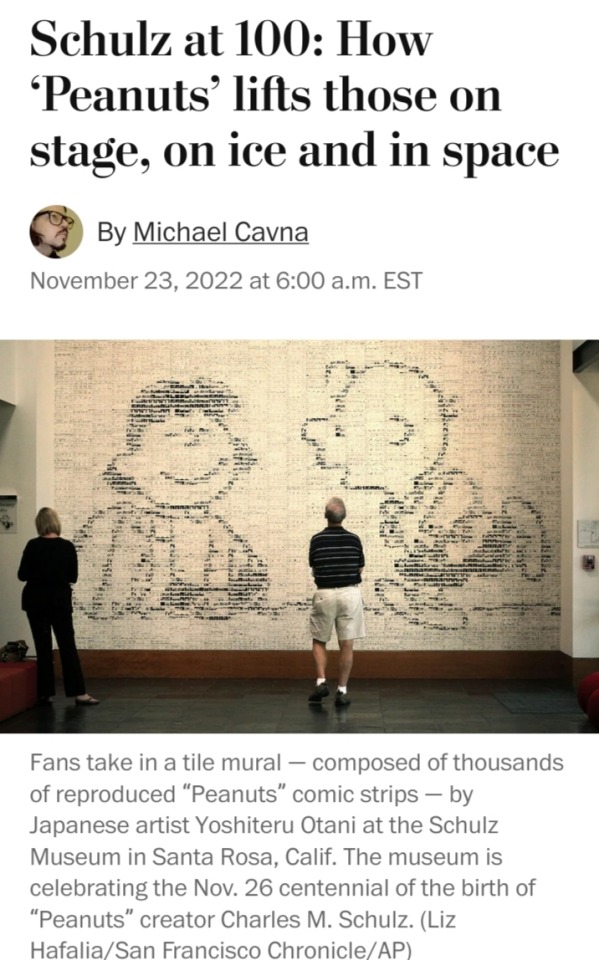
You can’t keep a good dog down, Charlie Brown.
When NASA launched a mission to the moon last week, the unmanned cabin included a stuffed Snoopy in an orange flight suit.
The space beagle was among the small items that serve as “zero gravity indicators,” which visually signal that the capsule has reached “the weightlessness of microgravity.”
Turns out, the agency couldn’t have picked a better pop culture symbol:
For seven decades, Snoopy and the rest of the “Peanuts” gang have defied the forces of time, freed from the gravitational pull of trends.
The globally beloved cartoon characters still pop up daily in comic strips, books and gift shops, as well as in animated specials, both new ones and the classic holiday programs such as “A Charlie Brown Christmas” that now stream on Apple TV Plus.
“Peanuts” is in the ether as surely as the jazzy Vince Guaraldi Trio riffs that bounce along the airwaves once Christmastime is here.

This year, the headquarters of Team Peanuts in Santa Rosa, California, has another reason to hold gatherings at its museum and library and ceremonies at its ice rink:
It’s the centennial of the birth of “Peanuts” creator Charles M. “Sparky” Schulz, who was born 26 November 1922 and raised in St. Paul, Minnesota.
Schulz died in February 2000, the same weekend that his final original strip was published.
Yet what he launched into the zeitgeist in 1950 remains a cultural touchstone. On Saturday, many syndicated cartoonists will mark the centennial in their strips.
So why does “Peanuts” endure so strongly — remaining so firmly woven into the fabric of popular culture — when so many aspects of mass entertainment all but disappear?
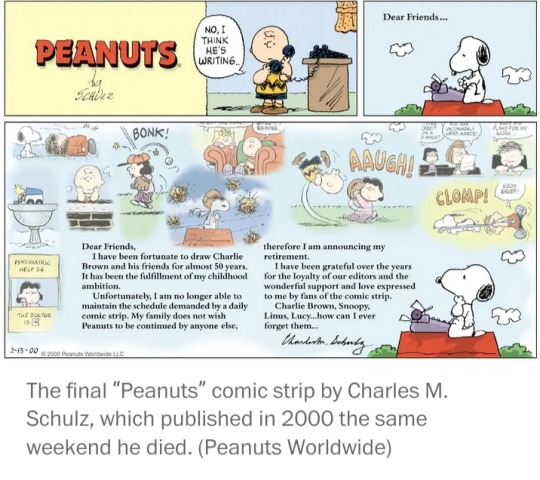
Jeannie Schulz, widow of the cartoonist and president of the Charles M. Schulz Museum’s board of directors, puts it concisely:
“Sparky tapped into a universal humanity and translated it into simple lines with a subtle humor.”
Those elegant, poignant, slyly simple lines curled and curved their way into religion and sports and war and mental health and love unrequited.
To mark the centennial, The Washington Post asked celebrities from various areas of achievement what Schulz’s creation has meant to them.
‘As good as anything ever’
Producer Lee Mendelson approached Schulz in the mid-’60s with an idea: Coca-Cola was interested in a TV project.
Out of that seed grew one of the two greatest animated Christmas shows to emerge from that decade: a classic that, like “How The Grinch Stole Christmas,” melded the genius of artistic minds.
Schulz teamed with animator Bill Melendez and, working under a deadline of mere months, the three men created “A Charlie Brown Christmas,” a masterpiece that daringly led with its heart.
Charlie Brown battled seasonal depression, Snoopy engaged in flights of fancy and Linus Van Pelt delivered the biblical monologue that, out of the mouths of a babe, still moves viewers regardless of age or faith.
“Over the course of my life, I’ve probably watched ‘A Charlie Brown Christmas’ more times than any single episode of television,” late-night host Jimmy Kimmel says. “It’s one of the main reasons I decided to have more kids.”
Kimmel thinks that special reflects the larger excellence of what a boy from Minnesota ultimately gave to the world.
“As soon as our daughter Jane learned to read, I bought her all the ‘Peanuts’ anthologies,” the comedian says. “I bought an original drawing of Snoopy by Charles Schulz that may very well be a forgery. I cherish it even if it is.
“The best of Peanuts is as good as anything ever. For me, it’s one of the greatest achievements in American art and literature.”
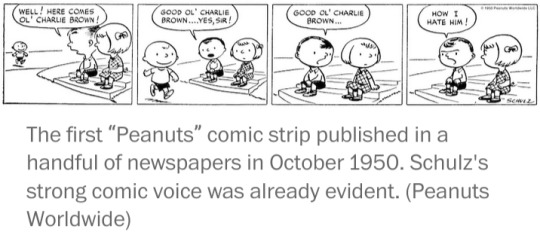
Pixar chief creative officer Pete Docter, director of such films as “Inside Out” and “Up,” says that brilliance was firmly rooted in the comic strip, which launched in fewer than a dozen newspapers before eventually being syndicated to thousands, becoming one of the most widely read strips in the world.
“Schulz was brave enough to talk about human, adult, often non-funny things in his strip,” Docter says. “He featured kids dealing with anxiety, insecurity, jealousy, unrequited love, which gave ‘Peanuts’ a real weight and importance.”
Growing up in Minnesota himself, Docter was drawn into a world that stays with him today.
“As a kid, I was totally hooked by Snoopy and the escapist fun and humor of that character,” he says.
“But whether Schulz was conscious of it or not, it was those deeper emotional things that made me continue to read into adulthood. Those deceptively simply drawn characters have real complexity and depth."
“And besides, they’re still funny 70 years later. How many comic strips can claim that?”
Bay Area author Gene Luen Yang considers how Schulz’s comic evolved from revelation to quiet revolution.
Says Yang, author of such graphic novels as “American Born Chinese”:
“He is so influential that pretty much every strip-format comic today, whether in the newspaper or on the web, has borrowed a bit of that innovation.”
‘We stayed close’
Ever the athlete, Schulz embraced baseball, golf and hockey from a young age. He grew to love sports like tennis and these passions regularly found their way into his strip.
Before he befriended some professional athletes well into his career, though, Schulz could not have known how much he buoyed them.
“As a young skater growing up, it was always fun to see the comic strip and celebrate everything we experienced at the rink,” says figure skater Scott Hamilton, who won Olympic gold in 1984.
“To see the ‘Peanuts’ [characters] come alive on the ice made it seem like what we were doing was more than just skating. We had a place in popular culture.”
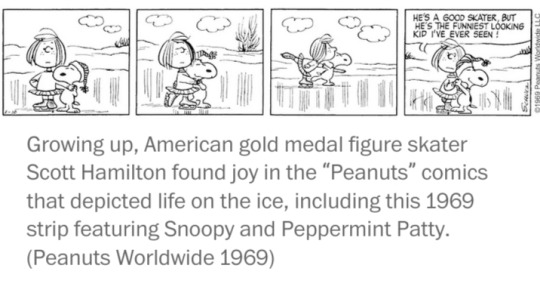
Schulz relocated to Northern California in the late ’50s, but you couldn’t take the Minnesota boyhood out of the man.
In Santa Rosa, he built the Redwood Empire Ice Arena, also known as Snoopy’s Home Ice, in 1969. And there, in the early ’80s, Hamilton began working with Schulz on ice shows.
(The skater will host “Sparky’s Ice Spectacular” at the venue on Saturday to mark the centennial.)
“Sparky was very hands-on in everything he did,” Hamilton says.
“In one of the productions I did for him, he had this dream of doing a cocktail party where I got to play the host of the party.
That character was interested in a girl at the party, but she gets swept off her feet by another guest, kind of like his stories of the Little Red-Haired Girl in the comic strip. Just when it seems he lost the girl, she comes back after all the other guests had left.”
Adds Hamilton, “To see how much Sparky loved that production made it one of my all-time favorite skating memories.”
Schulz also became a strong supporter of equality in sports, which included joining the board of trustees of the Women’s Sports Foundation, founded in 1974 by tennis icon and civil rights activist Billie Jean King, to “advance the lives of women and girls through sports and physical activity.”
Schulz would not only draw Snoopy serving aces. He would also reference his friend King.
“Sparky was actually very shy, and his comic strips were a great source of inspiration and comfort for me, especially as I traveled the world during my tennis career,” King says.
“I knew if he added my name to a ‘Peanuts’ strip, he was checking in on me and wanted to have a chat.
“We stayed close until he passed, and I will always cherish that.”
’A perfect pairing’
Mendelson, who died in 2019, believed in creative serendipity. He once told The Post that the first time he heard the music of Vince Guaraldi — while driving across the Golden Gate Bridge — he thought he might use it someday.
Singer-songwriter Ben Folds views Guaraldi’s music as inseparable from the classic “Peanuts” animation it accompanied.
“When you match the music with ‘Peanuts’ and the era and what it was doing and saying, then it starts to hit like Beethoven Piano Sonata time,” Folds says of Guaraldi’s sunny West Coast sound that “distilled jazz into something popular.”
Guaraldi’s “Peanuts” songs and the animated specials were “a perfect pairing,” he says, adding that the music “just gets the vibe.”
That “loomed large” when Folds was asked to write theme music for the recent streaming Peanuts special, “It’s the Small Things, Charlie Brown.”
He meditated on Guaraldi’s music rather than trying to imitate it: “I didn’t try to drop riffs. I just went with the color.”

‘Pursue their dream’
This month, “Jump Start” creator Robb Armstrong appeared on a Schulz Museum panel with other celebrated cartoonists to share personal stories about the Sparky they knew.
As he sat onstage, Armstrong appreciated that Schulz “made other budding artists either realize their dream, pursue their dream or smooth the road on their journey.”
“He was one of the most grand-hearted human beings I’ve ever encountered,” Armstrong says.
A 6-year-old Armstrong was inspired by “Peanuts” in the summer of 1968, when Schulz integrated the strip by introducing a Black character: Franklin.
Armstrong’s reaction: “I’m in this strip.”
(About a quarter-century later, Schulz gave Franklin the last name of “Armstrong” in a salute to his friend and syndicated colleague, an honor the “Jump Start” creator calls “otherworldly.”)
Barbara Brandon-Croft, the trailblazing creator of the comic “Where I’m Coming From,” also responded strongly in 1968.
“I was excited to see a Black character in ‘Peanuts.’ Even if Franklin’s presence was only that — a Black kid amongst the group — it absolutely made a difference,” she says."
“When you grow up as an ‘other,’ which is what this country laid out for us, when you see yourself represented, it gives you a sense of belonging.”
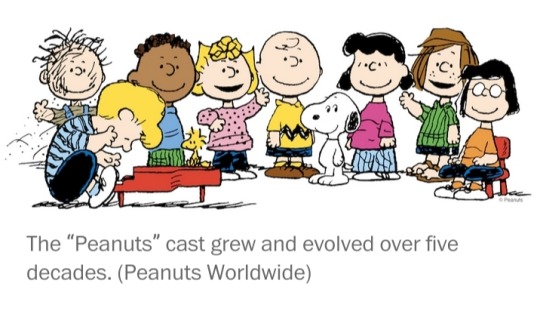
‘The cool astronaut’
Schulz, a World War II Army veteran, was long fascinated with aviation.
NASA and “Peanuts” have a long relationship that includes the Silver Snoopy Award, which is bestowed upon outstanding NASA contractors and employees.
In 1969, Schulz appeared in public alongside the Apollo 10 astronauts who rode in the module called “Charlie Brown.”
That was also the year that a future astronaut was inspired by Snoopy and space.
“In 1969, the Mets won the World Series, [astronauts] landed on the moon and I went to see ‘A Boy Named Charlie Brown,’ the new animated feature, at Radio City Music Hall, says Mike Massimino, an engineering professor and space adviser.
“It all happened within a few months of each other, and it kind of set up the passions for the rest of my life.”

That year, Massimino received a stuffed Snoopy astronaut toy as a gift.
In 2009, on his second NASA space mission, Massimino took that same Snoopy toy into space, a symbol of his lasting attachment to “Peanuts.”
Noting that his attempts to become an astronaut failed three times before he was accepted, Massimino says he admires Charlie Brown’s spirit of optimistic resilience.
“Charlie Brown is the friend and person I wanted to be, and Snoopy is the cool astronaut I wanted to be,” Massimino says.
Adds the astronaut, “I think it’s the greatest comic strip and characters ever created.”

74 notes
·
View notes
Note
happy wincest wednesday, ava!! what are your favorite samdean edits you've made so far? (top 5 or top 10)
thank you vicky 🥺 i'll do top 5! i'm sorry this is so late but wincest wednesday is more a state of mind, right???? RIGHT!
starting this off with my soft rock playlist because i'm gonna fail to ever make one of these posts again--i had a really good time putting the playlist together with several discord pals, which was essential help! i have limited knowledge of the genre and i was able to find some gems with their help, so: thanks to y'all <3 i like the composite feel that comes with the several images of different dimensions + i tend to shy away from these paler/overlaid filter style edits, so it was nice to push outside my (very shadowy) comfort zone.
fourth is a tie between this edit from one of my long time favourite songs and this dead in the water gifset! i couldn't decide because i like the first one for the fun narrative switch right at the end that takes it from sam's POV to dean's, but the second one is one of my favourite episodes and has a fun grimy look to it. all good things...
my third fave is unclean in the biblical sense because it really is the sam thesis, as i see it. it's simple, it's clean, and it distills several very important parts of his character in those early seasons into four gifs, which i'm quite proud of! i've seen other versions of this quote with various scenes but none of them have really gripped me and had me nodding along, so i had to make my own.
#2 is this season four parallels post because a. it's the first gifset i finished and thought that i might actually be... good at this... and b. not enough people talk about these VERY deliberate parallels!!!! i LIVE for them.
my this is how you lose the time war post is my number one. i am really proud of the colouring being so different for the different eras but still looking cohesive in the full post, in large part because it's fucking HARD to try to match the colour from kripke era to later seasons. this one was a unique challenge because it's important to me to match my edits with the vibe/theme of the original work, and that book handles time non-chronologically in a way i knew i had to echo with my edit. i felt i had to try to capture the way sam is so cordoned-off, even to the number one person in his life-- sam kept the amulet for YEARS. that is INSANE. his expression when dean finds out he had it this whole time is brain bending. having that in the script was such a beautiful way to illustrate the way sam works, which is that he has his own way to keep himself accountable and to remember the things that shaped him, ways he would never bring up to another person-- the amulet symbolizes his love for dean, his rebellion against john, his personal failures in season 4-- it's in his pocket every day to remind him of what he and dean were-- and then in season 11, with his sentimentality stripped bare in front of dean, it becomes what they are, here and now. and that's really neat.
20 notes
·
View notes
Text
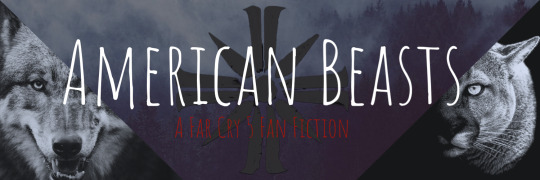
Chapter 16: I Send You Out as Lambs in the Midst of Wolves
Fandom: Far Cry 5, Far Cry (Video Games)
Rating: Mature
Warnings: No Archive Warnings Apply
Relationships: Female Deputy | Judge/John Seed, Female Deputy | Judge/Jacob Seed, Deputy | Judge/John Seed, Deputy | Judge/Jacob Seed
Characters: Deputy | Judge (Far Cry), Female Deputy | Judge (Far Cry), Joseph Seed, Cameron Burke, Earl Whitehorse, Mary May Fairgrave, Nick Rye, Kim Rye, Boomer (Far Cry), Grace Armstrong, Jerome Jeffries, John Seed, Faith Seed, Tracey Lader, Virgil Minkler, Hurk Drubman Jr., Sharky Boshaw, Adelaide Drubman, Joey Hudson, Peaches (Far Cry), Jacob Seed, Staci Pratt, Eli Palmer, Wheaty (Far Cry), Jess Black, Original Male Character(s), Project at Eden's Gate | Peggies, Tammy Barnes
Additional Tags: Canon-Typical Violence, Religious Fanaticism, Religious Cults, Religious Imagery & Symbolism, Swearing, Torture, Unhealthy Relationships, Animal Attack, Threats, Threats of Violence, The Seeds are Their Own Warning, Stabbing, Knives, Guns, Shooting, Non-Consensual Drug Use, Hallucinations, Sexual Humor, Sexually Suggestive Dialogue, Kidnapping, Villain Kissing, Kit is so Very Tired, John Being an Obsessed Weirdo, Blood and Violence, Gun Violence, More Biblical References to Lions Than You Can Shake a Stick at, references to murder, Trauma, Unreliable Narrator, Suicidal Thoughts, Not Canon Compliant, Past Child Abuse, Seeds Live, Deputy is Corrupted, Deputy Joins the Cult, Social Darwinism, Kit's Starting to Spiral into her Slow Decline into Insanity, Obsession, Murder Couple's First Meeting, Seed Family Meet Cute, Love at first sight??, Flashbacks
Summary:
Kit meets the members of the Whitetail Militia after having been saved from the Grand View Hotel, and introducing Caleb Winters, one of Jacob's Chosen, who gets an idea above his station
#fan fiction#far cry 5#jacob seed#staci pratt#eli palmer#wheaty#tammy barnes#jess black#oc: kit cross#oc: caleb winters
19 notes
·
View notes
Note
18, 22, and 29 for the fic asks, please!
18 - Do you title your fics before, during, or after the writing process? How do you come up with titles?
Oh this so, so depends on the fic, in part because every once and a while an excellent title descends upon me early in the process and also if I'm working on a fic for a while I have more time to think.
Usually my fics start out with placeholder titles that are whatever came to mind when I first saved the document; I'm yet to have one of those graduate to being a final title but that's partially because they're all things like this:



...and are often tonally different than what I'm actually going for.
As far as where my titles end up actually coming from, poems are a common culprit; I've got one or two song lyric ones, and some inspired by various other cultural references (ranging from like... pop cultural to Biblical). I tend to try to work in some wordplay, irony, or symbolism where I can, and love a title with layers.
Breaking down a couple recent ones:
Beharren ist eine Kunst -- German for "Persistence is an art," stemming from the longer proverb "Anfangen ist leicht, Beharren eine Kunst" (Beginning is easy, persistence an art), works particularly well for a story about an artist where "Kunst" doubles as a bit of a play on words.
Stemma Codicum -- A textual criticism term referring to the chart that can be drawn of different manuscripts relationship to each other (what was copied from what, where changes entered into the manuscript transmission process, and etc). Worked really well for a Pentiment fic about three "alternate timelines" all branching from a single change at a specific point in canon -- manuscript transmission as a metaphor for those critical points in people's lives that manage to change everything!
Long Upon the Land -- A tongue-in-cheek reference to Exodus 20:12, which reads ""Honour thy father and thy mother: that thy days may be long upon the land which the Lord thy God giveth thee"," as a title for a fic in which a character with an overbearing abusive father contemplates art and things that can outlast us across generations. Really loved the irony with this one, it's one of my favorites I've come up with in a while.
Needless to say they draw from all over the places, but I feel like between them it's pretty easy to get a feel for what I like in titles.
22 - Are there certain types of writing you won’t do? (style, pov, genre, tropes, etc)
I don't want to say there's for sure something I won't do, just because it seems like there's exceptions to everything (Pentiment wrung a "Major Character Death" warning tag out of me which is a new one!), but in general I am pretty allergic to most romance tropes. I'll write romantic relationships -- although my fics rarely center on them, but that's one of those things I'd be willing to assume might have an exception one day -- but when I do, they tend not to be particularly trope-y. There's just a lot of amatonormativity steeped into ideas like soulmates, fake dating, etc, and I'm not interested enough in them to consider ways to rehabilitate them in my own writing. I am but a tired aro and while it means I'll never write the most popular fic in any fandom I'm in, I get by perfectly fine in my little gen niche.
I'm also not a big fan of writing in first person (reading can go either way! I'm less into it in fic unless the canon itself is in first person, but fine with it in original fiction), but even that one has an exception on the horizon! If and when I finally write my TOH Sherlock Holmes pastiche, it'll probably be in first person, to mimic the original source material. So really that's a great example of why I have a pretty solidly "never say never" stance on most non-romantic tropes and devices.
29 - What’s your revision or editing process like?
I have a horrible confession to make. I edit as I go. My terrible perfectionist brain struggles to make peace with messy first drafts, and while I'll often give things a final, editor's eye read-through once I've finished writing, the bulk of my editing happens on repeated re-readings of the material throughout the writing process.
This is not a good way of doing things and I would love to break the habit, particularly since I think it would result in me writing more and faster. Do as I say, not as I do, everyone.
#[hides my face behind my hands]#in theory i am a decent writer but i have some BAD HABITS#my writing#ask meme
9 notes
·
View notes
Note
Laurence’s title is the Pearl Apostle. Pearl was mostly picked because of symbolism and I thought it was a fun reference even though he never calls Aphmau a pearl in this au. Apostle is being used in mostly the non-biblical way, though Laurence could technically be referred to as Zane’s apostle.
If Janus is Zane’s right hand then Laurence is Zane’s left. They often see to the crown’s most important issues because Janus is Zane’s strongest soldier and Laurence is his personal assassin. Laurence deals with any important situation that requires more intricate work. People whose deaths need to look like an accident, fugitives who need to be hunted down and dispatched without anyone’s notice, people who need to just disappear, etc. He also manages what is supposed to be the Jury’s ring of spies, though in reality it’s fully his. In the event of Laurence’s “termination” from the jury, their spies’ll go radio (amulet?) silent on Zane.
Laurence became a juror a couple years after graduating from the guard academy, resulting in him having an odd way of conducting himself. Around Zane or any juror he isn’t close to, he’s blank and serious, he won’t engage with anyone but Zane and Janus if it isn’t work-related. Around someone he likes, for example Jeffory, Laurence acts more like he did back in Meteli when he was around his friends and family. He’s not an entirely different person, but he’s definitely not the same anymore.
Ooh, I like that. Laurance doing a damn good at his job in the jury, and then forming a team of spies of his own as he learns more about Zane’s evils, especially with the chances of getting stabbed in the back being so high for anyone in the Jury. I like the idea of a scheming, lil more diabolical and intimidating and cold Laurance. I can see that being a lead-in to his conflict with Aphmau and Garroth once they start opposing Zane. Also,
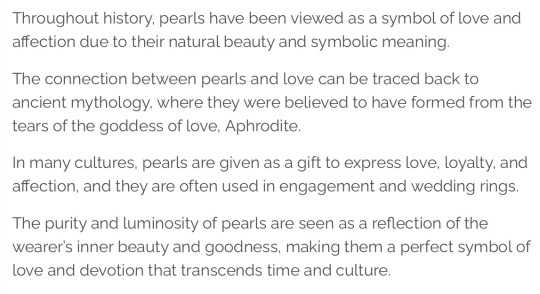
I never would’ve guessed pearls for Laurance, but I looked it up and the themes of “love, devotion, and loyalty” certainly would fit the world’s most romantic knight! I also see him as a very ocean-based guy because Meteli’s a trading port open to the waters, and like he could totally be a seafarer and live his dream on the seas if he wasn’t working at Aphmau’s side, and pearls are some of very few “gemstones” that come from the ocean, so, neat!
7 notes
·
View notes
Text
So, an interesting fact about me, I'm an agnostic with a degree in Biblical Studies from an evangelical megachurch diploma mill - I was going to school to be a pastor.
I spent a non-trivial amount of time with ancient Hebrew and Greek lexicons, reading the books of the Bible in their original languages. I did a lot of extracurricular study on the ecumenical councils - the bishops that voted on which books were going to be "the Bible" initially at the behest of the Roman emperor Constantine. I read a lot of the Gnostic texts that contributed to early Christian philosophy but were declared heretical a few hundred years after they were written.
The conclusion I came to was that if there were ever any spiritual truths in the texts that make up the Bible, they would've undoubtedly been obscured during Christianity's time as the official religion of the Roman Empire, if not excised entirely. Even just the fact that Christianity was the official religion of Rome often comes as a surprise to Evangelical Christians - they tend to be indoctrinated with a narrative that the Romans targeted Christians for persecution, they see Christians being thrown to lions as the representative image of Christianity in Ancient Rome. In reality, Roman historians are the ones that created that narrative in the first place, hundreds of years after the fact. The relationship between Rome and Christianity was complicated. For a couple of centuries, there was some scattered persecution, generally not targeted at Christians specifically. Ultimately, however, the Empire's attitude toward Christianity became essentially "if you can't beat them, join them."
The Roman Empire had need of an official religion and a holy text that reflected its values - xenophobia, patriarchy, slavery, expansionism - and the ecumenical councils provided it. People point out the hypocrisy of modern-day evangelicals for saying "God is love" but then hating women and minorities, but that is the religion of the Roman Empire, alive and well in 2023. It's a stretch to call the Roman Empire "fascist" (the word didn't exist yet), but the word fascism comes from Fasces, the symbol of Roman imperial magistrates. It is no coincidence that the more literally you interpret the Bible, the more comfortable you become with a nationalist Christian theocracy, as the Bible was assembled by the ecumenical councils to be a cultural assimilation handbook for new, recently-conquered subjects of the Roman Empire - the world's first "Christian nation." Modern-day Christians promote the idea that people are "twisting" the Bible to support hatred, bigotry, and oppression, but they're ignoring there was a period of several hundred years where anything that questioned the absolute racial and cultural supremacy of the Roman Empire and it's natural-born citizens was declared "heresy" and struck from the canon. It's a text whose primary purpose is to provide spiritual justification for conquering and subjugating people.
That means White Christian Nationalists aren't "misinterpreting" the Bible, they're using it exactly the way the Roman Empire intended it to be used. To codify and legitimize a caste system where native-born male citizens occupy the highest strata, and political leaders are the arbiters of God's will. It took a lot of re-writing to take the "proto-communist" teachings of the early Christian church and turn it into that Bible, but that's probably why most of what became known as "the New Testament" was written by Roman citizens, well after after Jesus' death. Fun fact: Saul of Tarsus - author of the Pauline epistles, otherwise known as "two-thirds of the New Testament" - was a natural-born Roman citizen that never met Jesus. As if that wasn't a tenuous enough connection, about half of the Pauline epistles are probably falsely attributed. We don't really know who wrote them, when, or why.
Once you recognize the bias, it is glaring. The Bible paints patriarchy as such a fundamental force of nature that salvation itself is an "inheritance" you have to become "joint heirs with Christ" (the Son of God) to receive. It says anyone violent or debased enough to seize power is "appointed by God" - a step further than even "might makes right," this says "might makes you the literal mouthpiece of God on Earth." If I'm being honest, at this point it wouldn't matter if the Bible were the infallible "Word of God" or not - if this is "God" talking, I wouldn't worship him just based on principle.
But it puts Christians in a difficult spot. You either have to concede that the Bible is fallible (which is heresy, according to evangelicals) or that God really does hate women, foreigners, democracy, and social equality. If a divine force "guided" the decisions of the ecumenical councils it would mean God endorses slavery, government authoritarianism, and racial supremacy. On the other hand, if there was no divine influence, then the entire Christian canon is essentially fanfic, philosophy cherry-picked by Romans to not be at odds with their own imperialist values. Either way, it's not representative of ideals I could dedicate my life to. I left the church before my ordination.
Before my mother passed, dismayed for my eternal soul, she used to tell me she prayed Proverbs 22:6 over me often - "Train up a child in the way he should go: And when he is old, he will not depart from it." Christians regard this scripture as a promise that if they raise their children to know God, they won't be led astray as adults. I wonder sometimes if she got what she prayed for, but in a different way than she expected. She raised me to know a God of love, of peace, with a heart of justice and understanding (which means tolerance, by the way - it's the ancient Hebrew word shâmaʻ which means to hear, and understand. When King Solomon prayed for "understanding" to lead his people, he was asking for the ability to hear and relate to people different than himself. That's what scriptural 'wisdom' is - empathy and compassion - you know, the things Evangelical Christians call 'woke' now). Because of it, now that I'm 'old', I can't be led astray by the callous Roman imperialist god of the Bible or the new capitalist American prosperity Jesus that didn't really mean what he said with "sell all you have and give to the poor."
Seems a little arrogant, doesn't it? Maybe even offensive. "I know the truth, everyone else is wrong." Who do I think I am? But since I exist, now old and still well-"departed" from the modern Christian church, the only alternative explanations are a) Proverbs 22:6 isn't actually a promise from God despite what the majority of western Christians believe, b) God doesn't keep his promises or, c) nobody is listening to prayers from little old church ladies and this whole 'god' thing is just ascribing anthropomorphic motivations to the forces of coincidence and random chance in the first place. As an agnostic, I don't really have any skin in that game, so feel free to pick whichever explanation sits best with you. Just remember, if you ever ask yourself "what would Jesus do?" - the answer might include flipping over tables in a church bookstore and chasing church-goers with a bullwhip.
6 notes
·
View notes
Text
Devilman: Crybaby, my take on it's religious refrences
In terms of religious allegory/refrences: 10/10
In terms of entertainment: 4/10
It's not an anime that I would typically enjoy as I am not a fan of nudity/p0rnography in anime at all, if the anime was not heavily under the inspiration of religion, I would not have watched it to begin with, but I didn't even end up finishing it.
To start with I love the opening way too much, it's what made me watch it in the first place but it set the bar a bit too high I think. I love the fragment where (what looks like)a reference to a biblically accurate angel occurs for few seconds with ryo's eyes. And the angel towards the end with 10 wings is stunning (or Ryo's angel form).


The first episode already had a few crosses; right before the sabbath club scene outside and during the scene it showed up two times, I'm pretty sure. The scene where Akira becomes the 'devil'man and his black silhoutte with wings, horns and claws with a red background and cross right behind him was beautiful. It seemed like the scene was saying that this is the god-like figure who came to save you. Him killing the demons right after kind of reaffirms this, it's as if he went on to punish those who sinned.
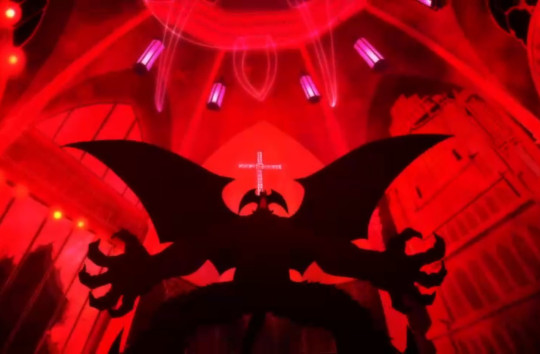
The whole world in this anime is depicted as a world without God's love. People becoming these demonic monsters is like people losing theirselves and their mind to their deepest darkest desires. How ironic that the one to 'save' them is a devil depicted as something of a Christ/God/saviour.
Oh and the beautiful painting of 'The Last Supper' by Leonardo Da Vinci in all of the dinner scenes is beautiful, maybe to understand why it's there I'd have to finish watching the anime, but I wonder if it's foreshadowing or symbolic of something that happens later on? And do the friend benito flakes that served Akira as reminder of his parents or his sudden huge appetite after turning into a devilman have something do with it or am I just overanalyzing.

Now the beautiful sountrack! I love it so much especially the song "Smells Blood" with it's inaudible lyrics that repeat "God can't stop me, we are coming, you are one of us, remember" and "I don't need God, because I'm him". Ah it's amazing although it plays during the scene where they search that creeps room illegally which didn't really make sense but it's great nonetheless (I'm pretty sure it plays during other scenes as well but I couldn't really tell). Not to mention the other songs with Christian inspired names like "The Genesis" and "From here to Eternity". They all sound really good too.
Without even finishing watching, I figured Ryo was an unusual character, lack of empathy, cold killer, unphased at the sabbath scene (him turning Akira into a devilman?) But once I read spoilers saying he was Satan/the fallen angel with a hermaphrodite form I was ecstatic, it's beautiful and so funny, to think that Satan himself would have such a pure white form while the devilman christ-like figure would look way more like satan himself.

Overall it's saddening that I wasn't able to enjoy and finish the anime, the blunt and straightforward Christian imagery and refrences was amazing. It was so out in the open which made me continue watching it for longer than I would have, had it been more subtle. It's a unique anime as I've yet to see one that's based on religion as heavily as this one.
Not to mention the way the anime portrays the complexity of humanity and relationships was great as well. And the many other cool (non-religious) metaphors and stuff that happens within the anime. The animation on the other hand...left me unamused. The anime was also just basically nudity the whole time, it was a hard watch for me.
3 notes
·
View notes
Text
Beacon of Love
As I'm seeing videos in YouTube about Judas Iscariot, the Judas/Love Tree (Cersis Siliquastrum), the Field of Blood (Akeldama) and the Gehenna Valley (Hell on Earth), I came with a thought.
To anyone who studied the Holy Books or at least know a bit of Hebrew History, Gehenna have quite a violent background (with wars and human sacrifices on the area) and even Jesus himself called this place as Hell on Earth (hence the name). So, we could say even in a holy city as Jerusalem, it took a dark part of history in this very valley.
As for Judas Iscariot, we know that after betraying Jesus, he was fill with horror, regret and sorrow. He tried to give back the coins to the priests, and they refused that. Throw the coins and ran to the place where he died.
The legend said that the tree he picked for his demise, originally had white flowers. Then when Judas committed suicide, the whole tree changed. The flowers turn white to pink/purplish color. It said it was because of Judas' blood or out of shame. Even the whole tree has detail about Judas himself. The buds where the seeds are placed looked like a hanged man. And the round leaves when fell to the ground and dry out, turn a bit of a silvery color. Reminds of the silver pieces.
This tree became the Judas Tree (Cersis siliquastrum) for the rest of history.
But also, it became a symbol beauty and romantic love. The tree is also known as the Love Tree. Also in Arabic, it means "Bride of the Forest", A very romantic symbolism for a tree where Judas Iscariot hanged himself, no?
In my honest opinion, after seeing lots of interpretations about the real reasons of Judas' actions (either in popular culture or Biblical study), could be beyond just accepting coins.
According to the Gospel of Judas, Jesus himself asked him to betray him, as Judas was especially close to him, his most devoted disciple. Surely, he could actually be the Beloved Disciple called in the Gospel of John (and people mistake this disciple as John, not Judas). Also, the fact that instead of giving any other signal, Judas kissed Jesus. That could be a possibility that Judas' feelings for Jesus was beyond a just a devotion of an apostle to their Rabbi.
Maybe romantic love.
But we know that homosexual love wasn't accepted in those times, so Judas had to hide his true feelings somehow, only expressing those when he and Jesus were alone.
If Judas' love was that intense that even transforms a whole tree... I mean, something so strong as love could even overcome any other negative feelings such a shame. There's no grief without love, and Judas grieved because he loved Jesus dearly.
As for Akeldama, the silver coins were used to purchase the area where all the unknown and non-Jew could have a resting area. A graveyard. And despite the name of Field of Blood, it became a resting place for all souls who needed somewhere to be buried properly. A place of respect and prayers. The Field of Blood became a sacred area.
And finally, Akeldama is located in the Gehenna Valley, the hellish place named in the Bible.
Maybe even in the most desperate and darkest places, there could be a beacon of light somehow?
For example, in the ending of the Comic of Judas, after accepting his new mission as the Shepeard of the lost and grieving souls in hell, he on his own became a beacon of light, of hope and love for all those who needs comfort. And Judas Iscariot became the symbol of light and divine comfort they needed in that hopeless world.
The existence of Judas, the Judas/Love Tree and Akeldama became a Beacon of Love in Gehenna on Earth.
Just as Judas Iscariot himself became the Beacon of Love in Hell for all the dammed souls trapped there.
So, even in the darkest place one could even imagine, there's still some light somewhere. Where hope and love are still possible.
Judas Iscariot became the Tree and Shepeard of Love on Earth and in Hell, to show that his intense romantic love and devotion for Jesus Christ, still resonates. And it's up to us to open arms and accepting his message of hope, forgiveness and the most beautiful feeling the universe could had ever created.
Love
#judas iscariot#judas of kerioth#jesus x judas#judas x jesus#jedas#chriscariot#judas comic#love tree#judas tree#cersis siliquastrum#field of blood#biblical theory#biblical thoughts#gospel of judas
6 notes
·
View notes
Note
Oh you know I'll take the opportunity to ask about vampires!! Can you tell me a little bit about the worldbuilding when it comes to vampire powers, weaknesses, and origins?
I would absolutely love to!! Also thank u for asking you know I love u @antique-symbolism I hope you’re having a FANTASTIC day 💖
So this project actually started as a bit (I never once intended for it to be my thesis but here we are, oops) when my fiancée and I were watching Lost Boys because she had never seen it (I’ve loved the movie for a while bc you can pry any non-twilight vampire media out of my cold dead hands)
That being said, a lot of the lore is very similar to Lost Boys! I’ve removed the idea of half-vampires and head vampires because that’s too complicated for this little novella, but essentially: sunlight=bad, sleep during the day (maybe they hang upside down like bats, just for fun), and to become one, not only do you have to be bitten, but you have to drink some of their blood as well. Very different from the Fool of Death Vampires, hahahahahahah
As far as powers go, they’re incredibly wildly strong, have WICKED GOOD eyesight/hearing/smell (the whole first scene involves them being Too Good at Carrie’s balloon popping carnival game) and as long as it’s night outside, they’re able to turn into bats and fly around. Also: they’re able to eat and enjoy regular human food, it just doesn’t give them any sort of nourishment, they simply must drink blood to live (that being said though, if they starve themselves they won’t DIE, they’ll just go starvation-crazy and end up probably murdering a bunch of people.) And we know I’m weak for a “these vampires are too sexy for their own good” moment, so they are obviously incredibly attractive (for whatever 1980’s standard they need to be at the time lmao)
Now, origins: Delilah is the oldest one out of the group, and she was turned in the early/mid 1800’s by her older sister, Leah. Leah kinda manipulated her into it, we don’t really get into it in the actual story (might write a short story based around it, tbh) but Delilah (being incredibly pissed off that her sister tricked her into this) killed Leah and decided to go and create her own family, because obviously her old family wasn’t one she could trust. Hence the arrival of the other girls, Judith being the youngest having only been turned in about 1945. They’re all in love and incredibly happy, even if they argue sometimes. They balance each other out.
Also, a fun tidbit: their names weren’t originally Delilah, Esther, Rebekah, Maggie, and Judith. They decided together as a group to all change their names, and they picked names for each other and all went biblical to be dramatic!!
The story doesn’t have much to do with killing them at all, it’s mainly an exploration of their humanity, however if you DID want to, decapitation is the way to do it! Not much else will work on these hardy motherfuckers
Thank you for letting me brain-dump onto your ask!! I hope this answered your questions and of course I loved getting the chance to talk about them ❤️🩸
#about the author#writeblr#my writing#my wips#lost boys wip#ask the author#antique-symbolism-main#writing#writing community#thesis#my ocs
3 notes
·
View notes
Note
Writer asks: 2, 5, 6, 7, 18, 20, 21, 23
2. Tell us about what you’re most looking forward to writing – in your current project, or a future project
In the "Princess and the Pea" story, I'm looking forward to writing some of the intruder's interactions with Auren. He is nothing like what she expects, and it'll be fun to see how her biases shift. And it'll be fun to see Auren with someone his own age in his own time period.
In the Marastel story, I'm looking forward to writing Marastel's moment of triumph--whatever it is. I've just figured out the character arc here and I think I can make something interesting out of it.
5. What character that you’re writing do you most identify with?
When I write Marastel, I have to be very careful to make her into her own character, rather than just a mirror of my own introverted, patient, anxious, and insecure sides. All my POV characters tend to mirror some aspect of my personality or moods, so that's always a struggle, but with Marastel more than most.
6. What character do you have the most fun writing?
Rilya is always a blast. I love writing self-assured, flippant characters who say whatever they want and are never more than 50% serious at any given moment. She's so easy to write. The dialogue just flows.
7. What do you think are the characteristics of your personal writing style? Would others agree?
Oh, boy. I don't know. Sparse description. Worldbuilding woven into the story. Casual dialogue. People getting emotional and talking about their trauma. A bit of snark mixed with a lot of romanticism. Maybe?
Would others agree? You'd know better than I would.
18. Do any of your stories have alternative versions? (plotlines that you abandoned, AUs of your own work, different characterisations?) Tell us about them.
When I did @awesomebutunpractical's character questionnaire, I became mometarily obsessed with an Arateph AU where Tanza was in Jemrauth's situation as reluctant ruler of the world. She was third daughter of the king, who preferred academic pursuits until she suddenly became crown princess. After she became queen, she became ruthlessly practical, enacting whatever decisions she thought best with little to no concern for other people's thoughts or feelings, and stoking the fires of revolt from among the populace and her nobles. They called her "The Queen of Thorns", because that's the meaning of her name and a good description of her prickly nature. (Her name was meant to reference a flower, but a slip of the tongue on her naming day changed the meaning, stripping away the blooms and leaving only the thorns).
She had no interest in sharing the throne, and reached her early thirties without a hint of a paramour. Until she traveled to Kepha and met Auren. He stumbled on her when she was wandering a tomb garden, and saw a softer side of her that she keeps hidden. They continued to interact, he started to introduce her to a non-cynical view of the concept of virtue, and she started to think that maybe people can be decent. People thought Auren was crazy for liking her, but he insisted that she had hidden depths, and she proved him right. She eventually married him--caring nothing for what people thought about her marrying someone from such a low branch of a low house--and though there's some struggle to conceive at her advanced age, they do have a daughter, who goes through the whole Sleeping Beauty story of the original.
20. Tell us the meta about your writing that you really want to ramble to people about (symbolism you’ve included, character or relationship development that you love, hidden references, callbacks or clues for future scenes?)
"Out of the Tomb" has tons of Biblical references. Most of the Great House names are inspired by the twelve apostles. Lord Rimath comes from Joseph of Arimathea, as the person who entombed the Christ figure. The town of Alogath comes from rearranging the sounds of Golgotha.
And then there are the references to other Sleeping Beauty stories. Carabos, of course, comes from Carabosse of the Sleeping Beauty ballet. The town of Roshen was derived from the German name of the fairy tale. And for other references--the hat chase game was taken directly from a suggestion of Chesterton's.
21. What other medium do you think your story would work well as? (film, webcomic, animated series?)
The story of Marastel and Jemrauth's courtship was partially developed when I undertook the imaginative exercise of structuring it as a musical. There's an opening number outlining their parents'/employer's expectations of them ["Expectations"]. A song that contrasts the fake romance Jemrauth has with Rilya with the real, but secret, relationship he has with Marastel ["Sparkle and Glow"]. There's a dramatic moment as the act break. It never got further than that, but the imaginary songs remain a part of my understanding of their story.
The "Princess and the Pea" story...live-action would be weird, since tephans are in the uncanny valley, though of course I'd love to see it play out onscreen. It's too sedate and talky for animation. I've suddenly considered the idea of radio drama, and while I'd prefer to see images, I'm fascinated by the idea of turning this voice and language obsessed universe into a sound-only story. Could we do sound layering things to make the naming tongue words have actual layers? There are some interesting possibilities.
23. What’s the story idea you’ve had in your head for the longest?
Overall, it's still A Beautiful Tomorrow, the Ruritanian-ish story about the teacher and the prince. I'm unlikely to do anything with it, since it's too Hallmarky, but it's still there taking up brainspace. There's also my one complete novel, a sci-fi "East of the Sun, West of the Moon" that I think of every once in a while. (Actually, just today, since praise-the-lord-im-dead's story made me realize that maybe my climax wasn't quite as dumb as I realized. Still dumb, because she set up hers much better, but not completely unrealistic.) I sometimes consider chopping it down to the good parts, because there are pieces of the character arcs I liked.
2 notes
·
View notes